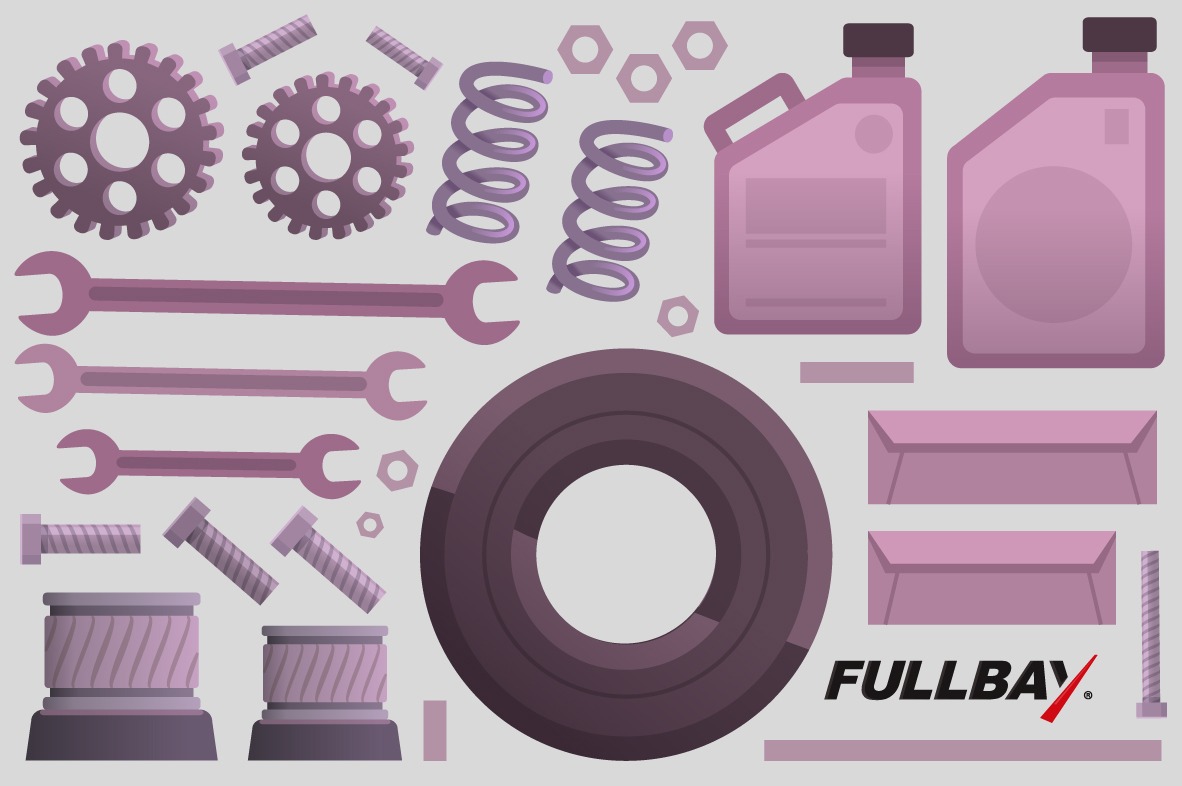Inventory 101: Manage Inventory Like a Pro

Inventory is your shop’s foundation. If you don’t have your inventory nailed down, the foundation will be weak and so will your bottom line. It’s possible to be profitable with a hit-and-miss approach to stocking parts. However, you’ll be more profitable if you’re managing inventory like a pro. Let’s take a look at the basic concepts you need to understand to get a grasp on inventory management.
Carrying Costs of Inventory
Carrying costs are the first thing you need to know about managing inventory. If you’re keeping stock on hand, it’s costing you more than what you paid for it. Generally, inventory carrying costs tend to run about 20 percent of the value. That may seem a little high, but consider all the factors that affect how much it costs to keep parts on hand:
- space—rent, own, or lease, the space those parts is sitting in costs money. Plus, you might be keeping parts in a space that could make money, like adding another bay.
- cash flow—buying inventory takes money out of your bank account, so you have fewer liquid funds to cover day-to-day expenses and emergencies
- damage, obsolescence, shrinkage, theft—parts get damaged, become outdated, misplaced, and outright disappear
Taking those things into consideration, 20 percent seems more reasonable. Still, applying that to the actual value of the stock your shop is carrying is sobering. For example, if you have $100,000 of parts on your shelves, it’s costing you $20,000 each year to carry it.
Know Where It Is
Once you understand carrying costs, it’s easier to see inventory as actual money. Naturally, you always know the status of your money, right? You know how many accounts you have, what the money in each is earmarked for, and what the balances are at all times. That’s how you should look at stock. You need to know where it is and how much you have at any given time.
That’s where having a system for managing inventory comes in. It should be a system that tracks the life of your stock from order through use. Plus, the system applies to everything, even parts that are stored on service trucks. Wherever stock is sitting, it’s still money. Use PO’s for parts purchases so you can easily see who ordered what and when. Plus, PO’s confirm which orders are legit and ensure you won’t end up paying vendor invoices for parts you didn’t order.
Next, having a receiving process makes parts easy to track. Additionally, going electronic with the entire process is much easier than sorting through a ream of paper bills and PO’s when you inevitably need to see who ordered or signed for a specific part. Ultimately, however, having an electronic receiving process is useful for nipping future headaches in the bud, especially when you need to track down an error or see where money is really being spent.
Finally, categorizing your parts isn’t just a symptom of OCD. It helps track down specific information on ordering, estimates, invoicing, and pretty much all areas important for managing inventory. That goes for parts stored on service trucks, too.
Count It
Managing inventory isn’t just about knowing where it is. You still need to count it. If the numbers on the list don’t match the numbers on the shelves, you have problems. Don’t settle for adjusting numbers to make them match, either. Manual adjustments affect your average cost and it all affects your bottom line.
Alternatively, true cycle counts reconcile what’s actually in the stockroom, and they don’t affect average cost. They’re a great way for tracking negatives, too. If you do negative inventory cycle counts daily, you’ll always have a handle on them, and you won’t have a big hairy mess to untangle at the end of the year.
Negative inventory is the only category you need to watch daily. You can split the rest of your stock into three groups we like to call the A-B-C’s. Fast moving parts are “A’s”; ones that move a bit slower, but still sell on a regular basis are “B’s”; and slow-moving parts that sell less frequently than every few months or so are “C’s”. Count them in cycles:
- Monthly: A’s
- Quarterly: B’s
- Every 6 months: C’s
Do counts electronically on your tablet so everything goes directly into the system without having to enter it twice. Also, put mobile techs in charge of counting parts that are stored on their trucks.
Stock Only What You Need
Stocking only what you need is a high-efficiency concept pioneered by Toyota, a company known for eliminating waste and doing things efficiently. Also known as Just in Time—JIT—the idea is to only keep on hand what is necessary and as little as possible. If you practice special ordering, you’re already practicing JIT.
It’s not reasonable to special order everything, though. Sending a $100 per hour tech to pick up a filter, for instance, isn’t a financially sound practice. Therefore, you have to balance things out. Stock things you use frequently, like supplies and parts for PMs: filters, brake pads, batteries, slack adjusters, etc. The key to managing inventory by stocking only what you need is the next step—understanding your flow.
Understand the Flow
Not many shop owners or managers can effectively stock their parts rooms off gut feelings. You have to do it by understanding the flow in your shop and that requires some historical data. Take a look at how much of each part in your stockroom you sold over the last year or more and how quickly it all sold. Going off the numbers and not what makes you feel warm and fuzzy is a more effective approach for managing inventory.
Looking at your shop’s history, figure out what your maximum and minimum numbers of each part are. Your minimum numbers are based not only on the smallest possible amount you need to get by but also on the lead time the vendor needs to get you those parts. Then, implement the process for ordering when your parts numbers drop to the minimum.
Occasionally, a shop has an incredible parts manager who seems to do their job instinctively. However, if you talk to them about their process, you’ll see that they actually have a method similar to this formula. Learn their process, write it down, and let everyone else in your shop in on the secret so anyone can do it.
Managing Inventory With the EOQ Formula
If you feel like you’re in chaos with parts and want a mathematically specific way of calculating the ideal amount of inventory for your individual shop, there’s a formula that will do it. It’s called the Economic Order Quantity equation and it takes specific information into account such as annual demand, fixed order costs, and carrying costs.
When figuring your fixed order costs, include the time it takes to make the orders and the amount per hour you pay the person who places them. For example, if you’re paying a parts manager $25 an hour and it takes him 15 minutes to order a filter, then the cost of that filter includes $6.25 for processing and receiving it. So, naturally, if the cost per hour can be decreased, then you don’t have to stock as many of those filters, because frequent orders are reasonable according to the equation, and that gets you closer to JIT. On the other hand, lower cost parts will also have lower carrying costs, so it would be practical to stock more of them and order less frequently.
Make Yourself Whole
Markup or margin? Whichever you use when managing inventory, you have to make yourself whole. Markup is easier to calculate, but there has to be a margin or you’re not in business. Markup percentage is your profit (your retail price minus your cost) divided by your cost. Margin is figured by dividing profit by your retail price.
Not to make things more difficult, but slapping a generic pricing scale on all your parts will negatively affect your profits. Use a graduated scale instead, applying higher margin/markup scales to lower-priced parts. You should also use different pricing scales for different vendors, different parts categories, and different sale types such as service orders versus over the counter sales. You might also want to apply different pricing scales to fleet, wholesale, and retail customers. Additionally, take into account what your competition is doing so you can play on the same field, offering customers comparable products and services priced in the same way other shops are pricing them.
Use the Right Tools
However you decide to calculate your retail prices, automating the process reduces chances of errors and inconsistency when managing inventory. The right tool makes all of it easier. Fullbay, for example, keeps track of stock from the first step through the last and takes the headache out of inventory processes like cycle counts. It prints barcodes for labeling parts and bins. It stores historical data you can access anytime to help solve parts stocking problems like JIT and EOQ. Plus, you can create multiple parts matrices and Fullbay will apply them to the right customers, parts, and vendors. Understanding Inventory 101 is the first step in managing inventory like a pro. Filling in the form below to get access to Fullbay is the next step.

